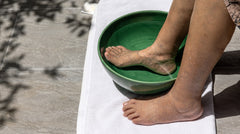Pond in a pot: water gardening tips for a peaceful backyard

Just looking at a body of water is enough to send most people to paradise. There’s something about the sparkle of light or the wind ruffling the surface that brings instant calm and relaxation. But not everyone can live lakeside or by the ocean. And not everyone wants the expense of a swimming pool. The perfect solution? A water garden.
Also known as aquatic gardens, water gardens can be any size — from a full-on, in-ground pond to a decorative pot that sits on your deck. They usually display aquatic plants, but many will house fish and other water-loving critters. They can also include fountains, waterfalls, rockwork, and special lighting. But don’t jump straight into the deep end on this one. Start with a small container that holds just a few gallons — to test the waters, as they say. Here’s how you can try out the idea of a water garden on a small scale, without committing a lot of money and time.
Pick a perfect pond pot for water gardening success
Get creative here, because all you really need is something that holds water. A kiddie pool, large plastic tub, or ceramic planter will do just fine. Or see what you can find cheap at a yard sale or flea market, like an old, freestanding bathtub. For a rustic touch, transform a watering trough or whiskey barrel just by adding a liner. What’s more, any of these containers can be recycled into planters. Whatever you choose, just make sure it can hold your submerged plants and pots, plus at least 4 gallons of water.
Location, location, location!
Place your container in a spot that receives around 6 hours of sunlight daily and isn’t near trees. Falling leaves are tough on water gardens since they can harm your fish and plants if you don’t clean them out. Even water gardens equipped with pumps and filters can have problems because leaves clog up the works. Keep your water garden in the clear by putting it in a tree-free spot.
Fill it with easy-care pond plants
If you don’t want your water garden to become an algae garden, you need at least two kinds of plants — submerged plants and surface plants.
- Submerged plants, which stay below the water surface, use up the nutrients algae need to grow. If fish swim in your water garden, submerged plants or “oxygenators” will also help them get enough oxygen.
- But don’t forget about surface plants. They can either float freely or grow upward from underwater pots. Cover at least 50% of your water garden’s surface with floating plants — like water lilies — that cast a shadow. These surface dwellers will slow algae growth by limiting the amount of sunlight that reaches the water.
Before putting pots of plants in the water, cover the soil with pea gravel so dirt won’t float out and into your water garden.
Keep the charm — nip problems in the bud
Container water gardens are practically maintenance-free. But here are some gardening tips that will keep you loving your little pot of paradise.
- Manage potential mosquito problems by inviting dragonflies to visit your water garden. They won’t bite or sting you, and they love to gobble mosquitoes, diving beetles, gnats, and flies. Even better, they can devour enough bugs in one day to equal as much as 15% of their body weight. Because dragonflies can also fly at speeds up to 35 miles per hour, mosquitoes don’t stand a chance. To make them feel at home, add water lilies to your pond, avoid using pesticides, and include a few rocks and sticks at the water’s edge.
- Fertilize with a water-soluble fertilizer, and use no more than half the amount recommended for the size of your container.
- Check the water level in your pond pot daily. Keep rainwater on standby so you can fill it when necessary.
- In the fall, when temperatures drop below 55˚F, bring your water garden indoors for the winter.

- FC&A Staff Writer







